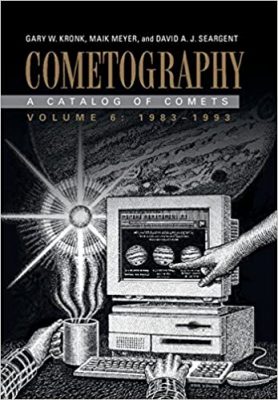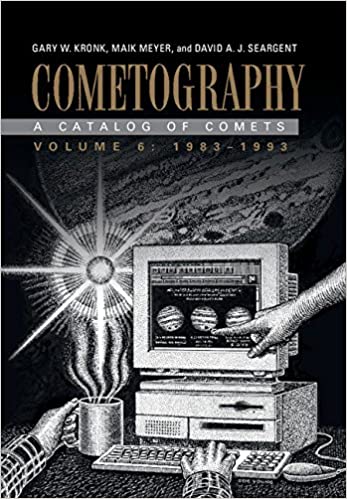 Authors: Gary Kronk, Maik Meyer, and David Seargent
Authors: Gary Kronk, Maik Meyer, and David Seargent
Publisher: Cambridge University Press – 845 pages
Book Review by: Nano Khilnani
Cometography is a multi-volume catalog of every comet observed from ancient times up to the 1990s, when the Internet took off as a medium of scientific record.
The authors of the volumes of Cometography use the most reliable orbits known to determine the distances from the Earth and the Sun at the time of discovery and last observation.
They also measure and record the largest and smallest angular distance to the Sun, most northerly and southerly declination, closest distance to the Earth, and other details, to enable the reader to understand each comet’s physical appearance.
Volume 6 is the final volume in the catalog. It covers the observations and pertinent calculation for every comet seen between 1983 and 1993.
The comets are listed in chronological order, with complete references to publications relating to each comet and physical descriptions of each comet’s development throughout its apparition.
Cometography is the definitive reference to comets through the ages, for astronomers and historians of science.
Contents
Introduction
Acknowledgements
Cometography: A catalog of Comets
Appendix 1: Uncertain Objects
Appendix 2: Periodical and Book Abbreviations
Person Index
Comet Designation Index
Authors:
Gary Kronk has had a life-long passion for astronomy, and has been researching historical information about comets ever sighting Comet Kahoutek in 1973-74. His work has been published in numerous magazines, and in two previous books: Comets: A Descriptive Catalog (1984) and Meteor Showers: A Descriptive Catalog (1988).
He holds positions in various astronomical societies, including Coordinator of the Comet Section of the Association of Lunar and Planetary Observers, and Consultant to the American Meteor Society. The International Union named minor planet 48300 Kronk, in honor of extensive research Gary Kronk has done in Cometography.
Maik Meyer has observed comets since 1987. Besides comet observing comets, he has been researching cometary orbits in order to link and identify historic comet appearances. His specialty area is the history of comet hunting. In 2002, he discovered the Mayer group of sun-skirting comets.
Meyer was the leader of the Comet Section of the German Vereingung der Sternfreunde and served as assistant editor of the International Comet Quarterly (ICQ). The International Astronomical Society named minor planet 52005 Maik, in honor of his research work on comets.
David Seargent studied and tutored philosophy at the University of New Castle, in New South Wales, Australia. He has also written books and articles on a variety of subjects. He has been an amateur astronomer since his early teens, with comets being his principal interest. Seargent directed the Australian Comet Section from early 1980s until early 2000s and acted as visual coordinator for Australia of Halley Comet Watch 1985-86. He is the discoverer of C/1978 T1 (Seargent).







